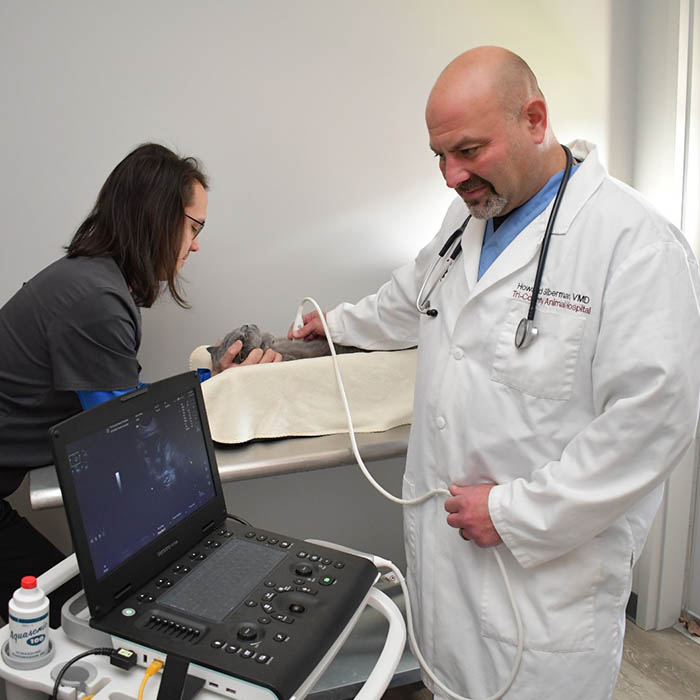The Role of Ultrasound and CT Scan in Modern Veterinary Practices: Insights From Experienced Professionals
In contemporary veterinary practices, ultrasound and CT scans significantly improve analysis capabilities. These imaging methods supply essential understandings into animal health and wellness, leading therapy choices. Experienced specialists recognize the one-of-a-kind advantages of each technique. Ultrasound uses real-time assessments, while CT checks provide intricate physiological information. Understanding their functions and applications increases important questions about their influence on person end results and the future of veterinary diagnostics. What insights can be gotten from their incorporated usage?
Comprehending Ultrasound in Veterinary Medication
Ultrasound is a necessary diagnostic device in vet medicine, supplying a non-invasive method to picture internal frameworks. This imaging method employs high-frequency sound waves to develop real-time photos of body organs and tissues, allowing veterinarians to analyze conditions without medical treatment. Common applications consist of examining the heart, liver, kidneys, and reproductive body organs, in addition to keeping track of pregnancies.The procedure is fairly fast and can be carried out in numerous setups, making it an accessible choice for veterinarians. Unlike radiography, ultrasound offers thorough details regarding soft cells and blood circulation, which is crucial for accurate diagnoses.Veterinary professionals count on ultrasound to identify problems such as growths, cysts, and fluid accumulation. Its capacity to direct biopsies and various other treatments further enhances its energy in scientific method. By supplying a reliable and risk-free method to analyze inner composition, ultrasound has become a keystone of modern veterinary diagnostics.
The Benefits of CT Checks for Animal Diagnostics
CT checks deal substantial advantages in vet diagnostics by giving improved precision in identifying interior problems (Board Certified Veterinary Cardiologist). As a non-invasive imaging strategy, they guarantee the safety and security and comfort of pets during assessments. Additionally, CT scans promote an extensive assessment of internal structures, permitting extra effective treatment planning
Boosted Analysis Precision
Developments in imaging technology have actually greatly improved analysis precision in veterinary medication, particularly with making use of CT scans. These scans provide thorough cross-sectional pictures of a pet's interior frameworks, allowing vets to determine abnormalities with precision. The high resolution and three-dimensional capabilities of CT imaging assist in the detection of conditions such as lumps, cracks, and inner bleeding that may be missed with standard imaging techniques. Additionally, CT scans can aid in pre-surgical preparation by providing a comprehensive view of physiological partnerships. This level of detail not just boosts the accuracy of medical diagnoses but likewise help in tailoring effective therapy plans. The assimilation of CT innovation right into vet techniques is transforming the landscape of animal health care, enhancing end results for clients.
Non-Invasive Imaging Strategy
The intro of non-invasive imaging techniques has transformed pet diagnostics, with CT scans becoming a famous tool in vet techniques. These scans give high-resolution, cross-sectional photos of a pet's internal frameworks, enabling vets to analyze complicated problems without the demand for invasive procedures. The advantages of CT scans include their capacity to discover growths, fractures, and internal bleeding with amazing accuracy. In addition, they help with the assessment of soft tissues and body organs, enhancing diagnostic capabilities. The rate of CT scanning enables quick decision-making, which is essential in emergency scenarios. By decreasing stress and anxiety and discomfort for the pet, CT scans contribute to a much more humane strategy to diagnostics, eventually enhancing therapy results and advancing vet care.
Comprehensive Internal Evaluation
A complete interior evaluation is important for accurate diagnosis and efficient treatment in veterinary medicine. CT scans offer significant advantages hereof, giving detailed cross-sectional pictures of an animal's interior frameworks. This advanced imaging technique boosts visualization of intricate anatomical areas, making it possible for vets to identify abnormalities such as tumors, fractures, and interior blood loss with greater accuracy. On top of that, CT checks facilitate the analysis of problems that may be testing to detect through conventional approaches. The rate and precision of CT imaging also add to timely interventions, improving client end results. As veterinary techniques progressively incorporate CT innovation, the advantages of considerable interior evaluations come to be noticeable, reinforcing the value of this device in modern vet diagnostics.
Contrasting Ultrasound and CT Imaging Techniques
While both ultrasound and CT imaging offer crucial duties in vet diagnostics, each method offers unique benefits and restrictions that can influence medical decision-making. Ultrasound is particularly valued for its real-time imaging abilities, enabling veterinarians to observe vibrant physiological procedures. This technique is non-invasive, portable, and does not entail ionizing radiation, making it a more secure choice for both animals and medical professionals. Ultrasound might have restrictions in picturing specific anatomical structures or deep tissues.Conversely, CT imaging gives in-depth cross-sectional sights of the body, enabling for accurate localization of abnormalities. It succeeds in examining complicated organs and frameworks, especially in the thorax and abdomen. CT scans call for sedation or anesthetic in numerous instances and involve direct exposure to ionizing radiation. Inevitably, the choice in between ultrasound and CT depends on the particular professional circumstance, the location of interest, and the necessity of the diagnostic needs.
Situation Studies: Effective Diagnoses With Imaging
Instance researches illustrate the substantial improvements in analysis accuracy attained through innovative imaging innovations like ultrasound and CT scans in vet practices. These improvements not just enhance the detection of different problems but likewise promote prompt and effective therapy strategies. Assessing particular situations can highlight the transformative influence of these imaging methods on vet medication.
Diagnostic Accuracy Improvements

Imaging Modern Technology Advancements
As vet imaging innovation remains to advance, its effect on analysis capacities comes to be progressively obvious. Recent case studies highlight the successful application of advanced ultrasound and CT check techniques in identifying complex problems. As an example, a vet facility used high-resolution CT scans to detect an dig this unusual type of lung cancer in a dog, which standard imaging had missed out on. An ultrasound assessment revealed an abdominal mass in a pet cat, motivating timely medical treatment and a favorable end result. These innovations not only improve diagnostic precision but likewise enable vets to devise targeted therapy plans. By leveraging advanced imaging modern technologies, veterinary experts are markedly boosting client treatment, resulting in extra efficient management of different health problems in animals.
The Duty of Imaging in Emergency Veterinary Treatment
Imaging plays an important duty in emergency vet care, giving vets with crucial info required to make quick, informed decisions. In immediate situations, methods like ultrasound and CT scans make it possible for experts to rapidly analyze an animal's inner frameworks, recognizing critical conditions such as internal blood loss, cracks, or organ problems. These imaging methods allow for real-time assessments, facilitating prompt interventions that can be life-saving. Ultrasound is vital for examining soft tissue injuries and problems like liquid accumulation, while CT checks offer comprehensive images of intricate physiological frameworks, vital for identifying injury cases. The rate and accuracy of these imaging methods enhance the veterinarian's ability to devise effective treatment strategies, making sure the very best feasible results for their patients. The combination of advanced imaging technologies right into emergency veterinary techniques is not just useful yet increasingly needed, as it improves diagnostic abilities and boosts overall pet treatment throughout vital moments.

Training and Know-how in Veterinary Imaging
Sophisticated imaging techniques such as ultrasound and CT scans are crucial for efficient veterinary care, the effective execution of these important link technologies heavily depends on the training and knowledge of veterinary professionals. Competent use of imaging tools needs detailed understanding of makeup, pathology, and the principles underlying each method. Veterinary professionals need to undergo specialized training to precisely translate imaging outcomes, which is vital for diagnosing conditions and preparing treatment.Certifications and proceeding education and learning in vet imaging enhance the abilities of professionals, allowing them to remain upgraded with technical innovations. Collaboration in between vets and radiologists typically causes enhanced diagnostic accuracy, as experts can offer understandings right into complicated instances. On top of that, practical experience in dealing with imaging tools cultivates confidence in its application. Ultimately, the quality of veterinary imaging services is straight associated to the degree of training and expertise had by the specialists making use of these essential analysis devices.
Future Patterns in Diagnostic Imaging for Animals
With the fast advancements in modern technology, vet diagnostic imaging is poised for considerable advancement in the coming years. Arising patterns indicate a shift in the direction of even more available and portable imaging methods, such as portable ultrasound devices, which could boost field diagnostics. Additionally, the combination of fabricated intelligence is expected to reinvent image evaluation, enabling quicker and much more accurate analyses of results.Moreover, innovations in 3D imaging methods and computed tomography will certainly offer veterinarians with even more complete sights of animal composition, bring about enhanced therapy strategies. Online reality innovation may likewise play a role in surgical planning and education, giving veterinarians a special point of view on complex cases.As telemedicine proceeds to grow, remote appointments facilitated by analysis imaging will certainly become more usual, allowing professionals to aid family doctors in real-time. Generally, these trends are readied to boost the effectiveness and efficiency of veterinary care, inevitably enhancing pet end results.
Frequently Asked Questions
Exactly How Much Do Ultrasound and CT Scans Price in Veterinary Facilities?
The costs of ultrasound and CT scans in vet facilities commonly range from $300 to $1,500, depending upon variables such as area, clinic kind, and details treatments required for the pet's medical diagnosis and therapy.

Are There Any Kind Of Threats Connected With Ultrasound and CT Scans for Pets?
Ultrasound and CT scans generally pose minimal risks to pets. Nevertheless, possible issues include sedation reactions and direct exposure to anesthetics. CT Scans For Dogs. Vets carefully evaluate each case to minimize any kind of dangers related to these diagnostic procedures
How Long Do Ultrasound and CT Treatments Generally Take?
Ultrasound procedures usually take about 30 minutes to an hour, depending upon the complexity. CT scans, being even more detailed, typically need 30 minutes to 90 minutes, consisting of prep work and recovery time for the pet dog.
Can All Veterinarians Perform Ultrasounds and CT Scans?
Not all veterinarians can do ultrasounds and CT scans. Specialized training and accreditation are usually called for to ensure expertise in these advanced imaging techniques, which may limit their schedule to veterinarians with added certifications and sources.
What Kinds Of Pets Profit A Lot Of From These Imaging Techniques?
Particular pet varieties, especially cats and pets, benefit greatly from ultrasound and CT scans. These imaging methods boost analysis find here accuracy for conditions like tumors, inner injuries, and body organ irregularities, bring about improved treatment end results and individual care. The high resolution and three-dimensional abilities of CT imaging assist in the discovery of problems such as lumps, cracks, and inner blood loss that may be missed with traditional imaging methods. Case studies highlight the significant improvements in diagnostic precision accomplished via advanced imaging technologies like ultrasound and CT scans in vet techniques. Improving diagnostic accuracy in veterinary methods has been substantially helped by innovations in imaging technologies such as ultrasound and CT scans. Advanced imaging methods such as ultrasound and CT scans are important for efficient vet care, the successful execution of these modern technologies heavily depends on the training and knowledge of vet professionals. Vet specialists must go through specific training to precisely analyze imaging outcomes, which is vital for diagnosing conditions and intending treatment.Certifications and proceeding education and learning in vet imaging enhance the abilities of specialists, allowing them to stay upgraded with technical innovations.